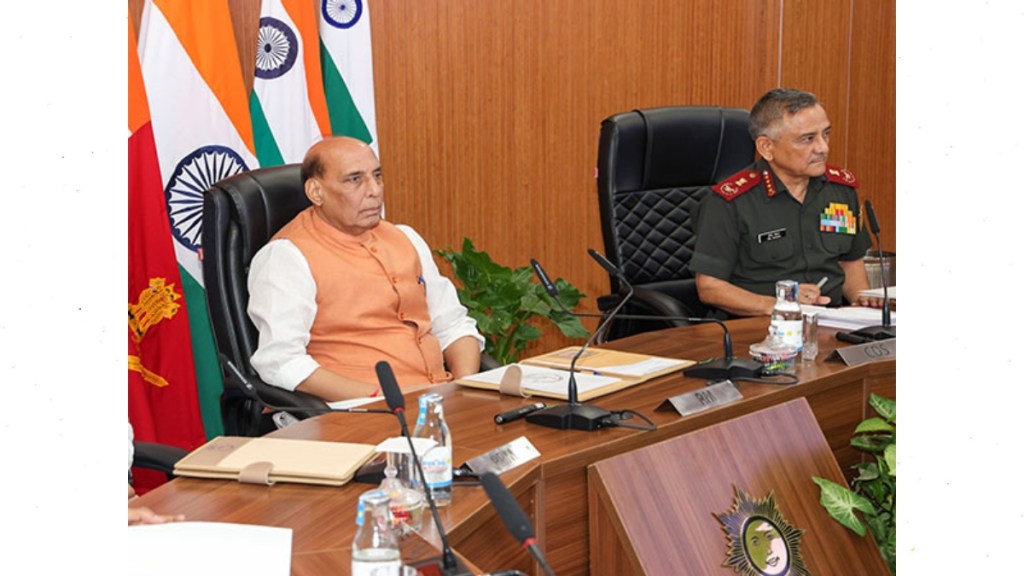The Joint Commanders’ Conference in Lucknow, presided over by Defence Minister Rajnath Singh, concluded with a powerful focus on transforming India’s military for future challenges. The two-day event brought together the top military leadership of the country, aiming to enhance jointness and integration across the armed forces. The conference underscored the urgency of modernizing India’s defence capabilities to face evolving threats, while strengthening the nation’s position as a peace-loving yet prepared global power.
Strategic Vision for a Safer India
At the heart of the conference was the theme “Sashakt aur Surakshit Bharat: Transforming the Armed Forces,” where Singh emphasized the importance of preparing for future conflicts, particularly in light of global uncertainties. Referring to ongoing international conflicts, including the Russia-Ukraine war and regional instability in Bangladesh, Singh urged the commanders to study these developments closely and anticipate the challenges that India might face. His message was clear: India must be ready for unexpected threats to ensure lasting peace in the region.
He highlighted that while India enjoys a rare peace dividend amidst global volatility, the increasing complexity of threats demands constant vigilance. “We need to ensure that our peace is maintained during this crucial phase of Amrit Kaal,” he said, stressing the need for fail-proof deterrence and a robust national security apparatus. The emphasis on balancing current threats with future preparedness set the tone for discussions at the conference.
Technology and Capability Development
One of the major outcomes of the conference was the focus on the integration of cutting-edge technologies such as artificial intelligence (AI), electronic warfare, and space-based capabilities into India’s defence strategy. Singh stressed the growing role of AI and data analytics in modern warfare, stating that these technologies, while not directly involved in conflict, are increasingly determining the outcomes of war. He called for the armed forces to embrace technological advancements to remain future-ready, especially in domains like cybersecurity and space defence.
The minister also highlighted the importance of developing India’s capabilities in space and electronic warfare, noting that these fields will play a critical role in future conflicts. He urged military leaders to invest in both traditional and modern warfare equipment to ensure India’s readiness in an increasingly complex geopolitical environment.
Strengthening Self-Reliance in Defence
Another key takeaway from the conference was the reaffirmation of India’s commitment to achieving self-reliance in defence under the ‘Aatmanirbhar Bharat’ initiative. Singh underscored the government’s efforts to indigenize defence production, which includes equipping the armed forces with state-of-the-art indigenous weapons and platforms. The emphasis on indigenization reflects India’s strategic shift toward reducing its dependence on foreign military equipment and building a more robust domestic defence industry.
The conference also delved into the importance of theaterisation and organizational restructuring to enhance joint operational capabilities across the three services – the Army, Navy, and Air Force. The discussions centered around creating a more integrated response mechanism during peace and conflict, ensuring that the armed forces can swiftly and effectively address any threats to national security.
Preparing for Multi-Domain Warfare
One of the most significant themes that emerged from the conference was the increasing importance of preparing for multi-domain warfare, which includes land, air, sea, cyber, and space. Special attention was given to the strategic importance of cyber and space-based capabilities in modern conflicts, as well as the need for advanced robotics and AI-enabled autonomous weapon systems. These discussions signal a recognition of the changing nature of warfare, where battles are fought not just on physical frontlines but also in cyberspace and outer space.
The commanders reviewed international developments impacting India and deliberated on ways to further strengthen the country’s defence capabilities. The focus on emerging technologies and future capabilities points to a broader shift in India’s military thinking – one that prioritizes innovation, integration, and preparedness for the next generation of warfare.
Additional Outcomes and Key Initiatives
In addition to the strategic discussions, the conference also saw the launch of eight innovative applications, including e-Museum and e-Granthalaya, aimed at fostering greater cohesion among the three services. Another notable launch was the publication “Colonial Practices and the Armed Forces – A Review,” which marks a significant step toward re-evaluating and modernizing legacy military structures in India.
The Joint Commanders’ Conference, attended by senior officials including Chief of Defence Staff General Anil Chauhan, and the Chiefs of the Army, Navy, and Air Force, provided a comprehensive forum for India’s top military brass to reflect on current challenges and strategize for the future. The inclusion of various defence secretaries and officials from the Ministry of Defence ensured that the discussions were holistic, covering not just military strategy but also defence production, research and development, and ex-servicemen welfare.

